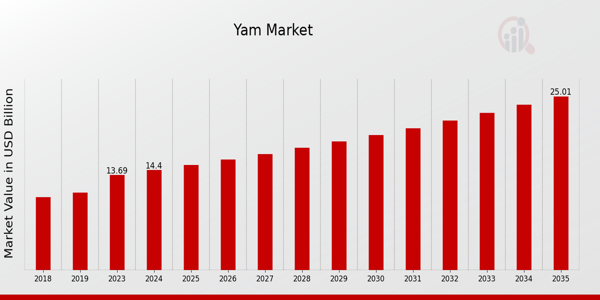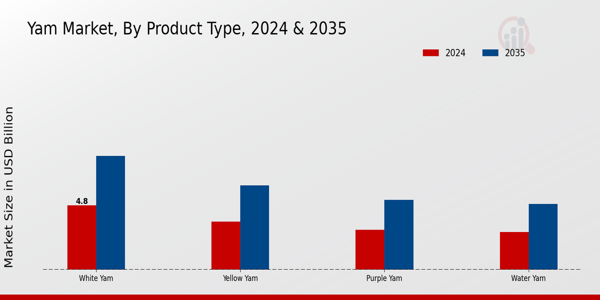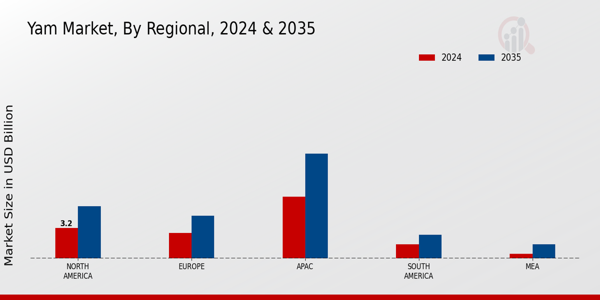Yam Market Overview:
As per MRFR analysis, the Yam Market Size was estimated at 13.69 (USD Billion) in 2023. The Yam Market is expected to grow from 14.4 (USD Billion) in 2024 to 25.0 (USD Billion) by 2035. The Yam Market CAGR (growth rate) is expected to be around 5.15% during the forecast period (2025 - 2035).
Key Yam Market Trends Highlighted
The growing desire for nutritious food options and the nutritional advantages of yam are two major market drivers that impact the global yam industry. The benefits of eating yams, such as their high fiber content and numerous important vitamins and minerals, are becoming increasingly widely recognized by consumers.
The market is growing as a result of growing interest in plant-based diets and the versatility of yam in a variety of culinary applications. Furthermore, growers may now increase food yields to better meet growing demand thanks to improvements in agricultural practices and procedures.
Investigating novel product innovations and cutting-edge processing techniques can reveal potential prospects in the global yam market. There are opportunities for market penetration due to the growing popularity of ethnic cuisines and organic food. By launching yam-based goods like snacks, flour, and nutritional supplements, producers can take advantage of these trends.
Expanding distribution channels, particularly in regions with a lesser-known presence of yams, can unlock potential consumer bases and create a greater appreciation for this root vegetable. Similarly, engaging in marketing strategies that emphasize sustainable farming practices can resonate with environmentally conscious consumers.
In recent times, there has been a noticeable trend toward online shopping for diverse food products, including yams. As e-commerce continues to grow, online platforms provide wider access to various yam products and cater to a growing customer base interested in convenience and variety.
Additionally, social media has played a role in disseminating recipes and cooking tips that feature yams, further piquing interest. This digital shift has fostered innovative marketing strategies that highlight the versatility of yam, reinforcing its position in modern diets.

Source: Primary Research, Secondary Research, MRFR Database and Analyst Review
Yam Market Drivers
Rising Health Consciousness Among Consumers
The increasing awareness of health and nutrition among consumers is a significant driver in the Global Yam Market. With a growing focus on healthy eating and natural foods, yams are gaining popularity due to their numerous health benefits, including rich nutritional content, high dietary fiber, and antioxidant properties.
These intrinsic qualities make yams a preferred choice for health-conscious individuals. As people become more discerning about their dietary choices, the demand for nutritious and wholesome food options rises, thereby propelling the growth of the Global Yam Market.
Additionally, yams are gluten-free, making them suitable for individuals with gluten sensitivities or celiac disease. This shift towards healthy eating habits is expected to sustain the momentum within the market, leading to sustained growth and innovation in yam products.
The continued exploration and promotion of yams as a superfood will enhance consumer interest and further expand their consumption across various demographics.
This trend aligns with the broader movement towards holistic health and wellness, signifying a major opportunity for players in the Global Yam Market to introduce diversified products that cater to these emerging consumer preferences.
Increasing Demand for Ethnic Foods
The growing global inclination towards diverse culinary experiences is a formidable driver in the Global Yam Market. As consumers explore various international cuisines, yams serve as a staple ingredient in many cultures, particularly in African, Asian, and Caribbean cuisines.
This rising interest in ethnic foods not only increases the demand for yams but also boosts the sales of related products. As restaurants and food service establishments expand their menus to include traditional dishes, yams represent an adaptable and versatile option that appeals to both local and international markets.
Moreover, the fusion of ethnic flavors into mainstream dishes enhances yams' appeal, ultimately contributing to the sustained growth within the Global Yam Market.
Innovative Product Development and Applications
Innovation in product development is a significant driver influencing the Global Yam Market. Producers are increasingly developing new yam-based products, including snacks, flour, and health supplements, to cater to evolving consumer preferences.
This innovative approach not only helps improve the market reach but also enhances the functionality and versatility of yams in various culinary applications. Additionally, the rise of convenience foods encourages manufacturers to explore yam's potential in ready-to-eat meals and processed foods, which captures the interest of busy consumers looking for quick and healthy options.
As the market evolves, the ongoing research and development efforts will likely lead to even more diverse applications of yams, driving growth further.
Yam Market Segment Insights:
Yam Market Product Type Insights
The Global Yam Market exhibited diverse dynamics, particularly when segmented by Product Type, which includes significant categories such as White Yam, Yellow Yam, Purple Yam, and Water Yam.
White Yam stood out as the largest segment, with an estimated valuation of 4.8 USD Billion in 2024, demonstrating a majority holding within the market. This dominance can be attributed to its widespread cultivation and preference across various culinary applications, providing essential nutrition and versatile incorporation in meals.
Following closely was the Yellow Yam segment, valued at 3.6 USD Billion in 2024, known for its sweeter taste compared to other variants and its essential role in traditional dishes across several cultures, contributing to its significant market presence.
Meanwhile, the Purple Yam, valued at 3.0 USD Billion in 2024, captured the attention of health-conscious consumers due to its antioxidant properties and vibrant color, increasing its appeal in the health and wellness sector and making it a noteworthy player within the Global Yam Market.
Conversely, Water Yam, with a valuation of 2.8 USD Billion in 2024, appealed primarily to specific regional cuisines and was often lauded for its unique texture and flavor, although it held a comparatively smaller share of the market.
The expected growth in these segments signals increasing consumer awareness and a shift toward traditional and organic food sources. Market trends suggest that the consumption of yams is on the rise, driven by their nutritional benefits and the growing trend of plant-based diets.
Each of these segments presented unique opportunities; however, challenges remained in terms of cultivation practices, climate impacts, and the need for improved supply chain efficiency. Overall, the Global Yam Market segmentation indicated a rich tapestry of product types, each with its distinct characteristics, driving factors, and trajectories contributing to the market's growth.
By 2035, the market dynamics are expected to evolve significantly, with White Yam projected to reach 8.5 USD Billion, showcasing its sustained dominance, while Yellow Yam and Purple Yam are also expected to experience notable growth to 6.3 USD Billion and 5.2 USD Billion, respectively.
Water Yam, while increasing to 4.9 USD Billion, will continue to face competition from its more popular counterparts but still holds a unique niche in the market. Understanding the Global Yam Market data reveals a promising future, suggesting that all product types will continue to evolve, driven by changing consumer preferences and market demands.

Source: Primary Research, Secondary Research, MRFR Database and Analyst Review
Yam Market Application Insights
The Global Yam Market has been increasingly recognized for its diverse applications across various industries. The food industry stands out as a major consumer of yam products, driven by the growing demand for natural and nutrient-rich ingredients.
Meanwhile, the pharmaceutical sector utilizes yams for their therapeutic benefits, contributing to the market's expansion. In cosmetics, yam extracts are valued for their role in skin health and beauty formulations, further diversifying the market's appeal.
Additionally, the animal feed segment plays a crucial role in the Global Yam Market, as yams serve as a nutritious feed source for livestock. A notable trend is the rising consumer preference for plant-based products, which supports growth across all these applications.
While opportunities abound, challenges such as supply chain fluctuations and market competition may impact growth. Insights into Global Yam Market statistics reveal that these segments collectively shape a dynamic landscape, highlighting the importance of yams in both traditional and modern applications.
As the market evolves, understanding these insights will be key for stakeholders aiming to capitalize on its growth potential.
Yam Market Form Insights
Within the Form segment, the market showcases various types of yams, including Fresh, Frozen, Dried, and Processed, each holding unique significance. Fresh yams cater to the growing consumer demand for healthy and natural food, making them a key player in the market's revenue generation.
The Frozen segment benefits from the rising trend of convenience food, appealing to busy consumers, while Dried yams serve as an essential ingredient in various culinary applications, particularly in regions valuing long shelf life and preservation.
Processed yams, including yam flour and snacks, are gaining traction due to the increasing preference for ready-to-eat and convenient meal options.
With Global Yam Market statistics indicating a steady growth rate, the industry is facing both challenges and opportunities, such as ensuring supply chain sustainability and reaching untapped markets. Overall, the diverse forms of yams contribute significantly to the Global Yam Market revenue, reflecting changing consumer preferences and market dynamics.
Yam Market Distribution Channel Insights
The market segment is characterized by a diversification of channels, including Online Retail, Supermarkets, Specialty Stores, and Wholesale, each playing a crucial role in reaching consumers.
Online Retail has become increasingly significant due to the rise of e-commerce, providing convenience and wider reach, while Supermarkets dominate the landscape with their extensive foot traffic and consumer accessibility, catering to a broad audience.
Specialty Stores focus on niche markets and provide targeted offerings, enhancing customer experiences, which makes them an important player in the market. Wholesale channels facilitate bulk purchasing and distribution, serving as a critical backbone for the supply chain.
Collectively, these channels reflect current market trends emphasizing convenience and accessibility, driven by changing consumer behaviors and preferences, and present numerous opportunities for growth while navigating challenges such as competition and supply chain logistics.
The Global Yam Market segmentation continues to evolve, driven by these dynamics in the distribution landscape, offering a comprehensive view of where the dynamics of market growth are actively happening.
Yam Market Regional Insights
The Global Yam Market showcased a diversified landscape across its regional segmentation, with apparent strengths in various areas. In 2024, North America held a valuation of 3.2 USD Billion, demonstrating a significant market presence that is anticipated to grow to 5.5 USD Billion by 2035.
Europe was another key region valued at 2.7 USD Billion in 2024, showing a strong potential to reach 4.5 USD Billion by 2035 as consumer preferences pivot towards healthier food options. The Asia-Pacific (APAC) region dominated the market with a valuation of 6.5 USD Billion in 2024, projected to expand to 11.0 USD Billion by 2035, reflecting both high production and consumption rates that place it in a leading position.
In contrast, South America and MEA were smaller segments at 1.5 USD Billion and 0.5 USD Billion in 2024, respectively. However, they presented growth opportunities as health trends gained momentum, with South America expected to reach 2.5 USD Billion and MEA 1.5 USD Billion by 2035.
The varying dynamics in these regions illustrated the Global Yam Market revenue's responsiveness to local consumer behaviors and agricultural capabilities, emphasizing the importance of regional strategies in achieving sustained growth.

Source: Primary Research, Secondary Research, MRFR Database and Analyst Review
Yam Market Key Players and Competitive Insights:
The Global Yam Market is characterized by diverse competition, with a plethora of companies vying for market share in various regions across the globe. This market presents numerous opportunities for growth driven by increasing consumer awareness of nutritious food options and the rising demand for exotic and healthy food ingredients. The competitive landscape is shaped heavily by factors such as product innovation, pricing strategies, supply chain efficiencies, and the ability to cultivate sustainable practices.
As consumers' preferences evolve, the need for companies to adapt and differentiate their offerings has never been more crucial. Companies are keenly focused on expanding their geographical reach while also catering to the changing tastes of health-conscious consumers. This competitive environment prompts constant evaluations of market strategies, necessitating companies to leverage both technological advancements and innovative farming practices to stay ahead.
Driscoll has established a significant presence in the Global Yam Market owing to its commitment to high-quality produce and sustainable farming practices. Known for its rigorous selection processes and thorough quality control measures, Driscoll's is revered for providing premium yam products that meet the diverse needs of customers.
The company excels in its marketing and distribution strategies, allowing it to effectively connect with consumers around the world. Its strong brand reputation is bolstered by strategic collaborations and partnerships with various stakeholders across the supply chain, ensuring steady availability and quality of yams.
Driscoll's commitment to environmental sustainability, coupled with its focus on innovation, positions it favorably in the competitive landscape, enabling it to respond adeptly to market demands while maintaining a strong foothold in the industry.
Dole Food Company plays a vital role in the Global Yam Market, leveraging its extensive distribution network and established market presence. Renowned for its commitment to delivering high-quality yam products, Dole Food Company focuses on providing a variety of yam types that cater to diverse culinary needs and consumer preferences.
The company benefits from its strong brand recognition and loyal customer base, contributing to its competitive advantage. Dole's emphasis on sustainable agriculture and responsible sourcing further enhances its reputation, appealing to a growing segment of environmentally conscious consumers.
By continuously investing in research and development, Dole Food Company aims to innovate and enhance its product offerings, ensuring they align with consumer trends and nutritional demands. The company's ability to navigate market challenges while maintaining rigorous quality standards underscores its strength in the Global Yam Market, positioning it as a formidable competitor.
Key Companies in the Yam Market Include:
- Driscoll's
- Dole Food Company
- Sunset Produce
- Olam Group
- Greenyard
- Bonduelle
- Taylor Farms
- Total Produce
- Chiquita Brands International
- Fresh Del Monte Produce
Yam Market Developments
Recent developments in the Global Yam Market indicate a growing interest in sustainable practices among major companies. Driscoll and Dole Food Company have recently announced initiatives to enhance their supply chain transparency, aiming to promote responsible sourcing of yams.
Meanwhile, Olam Group has seen a notable increase in consumer demand for organic yams, leading to expansion in their organic product lines. In terms of mergers and acquisitions, Total Produce has gained significant traction after acquiring a regional player, enhancing its market presence across various territories.
Chiquita Brands International is also exploring strategic partnerships to bolster its yam distribution network, particularly in Europe and North America. Furthermore, the market valuation of Sunset Produce and Taylor Farms has shown substantial growth, reflecting increased investment in innovative farming techniques and technology.
The rising consumer awareness regarding health benefits associated with yam consumption is driving market demand, with companies like Fresh Del Monte Produce actively launching new yam-based products to cater to this trend. Overall, while challenges remain, the focus on sustainability and expansion strategies is shaping the future of the Global Yam Market.
Yam Market Segmentation Insights
Yam Market Product Type Outlook
- White Yam
- Yellow Yam
- Purple Yam
- Water Yam
Yam Market Application Outlook
- Food Industry
- Pharmaceuticals
- Cosmetics
- Animal Feed
Yam Market Form Outlook
- Fresh
- Frozen
- Dried
- Processed
Yam Market Distribution Channel Outlook
- Online Retail
- Supermarkets
- Specialty Stores
- Wholesale
Yam Market Regional Outlook
- North America
- Europe
- South America
- Asia Pacific
- Middle East and Africa
| Attribute/Metric Source: |
Details |
| MARKET SIZE 2023 |
13.69(USD Billion) |
| MARKET SIZE 2024 |
14.4(USD Billion) |
| MARKET SIZE 2035 |
25.0(USD Billion) |
| COMPOUND ANNUAL GROWTH RATE (CAGR) |
5.15% (2025 - 2035) |
| REPORT COVERAGE |
Revenue Forecast, Competitive Landscape, Growth Factors, and Trends |
| BASE YEAR |
2024 |
| MARKET FORECAST PERIOD |
2025 - 2035 |
| HISTORICAL DATA |
2019 - 2024 |
| MARKET FORECAST UNITS |
USD Billion |
| KEY COMPANIES PROFILED |
Driscoll's, Dole Food Company, Sunset Produce, Olam Group, Greenyard, Bonduelle, Taylor Farms, Total Produce, Chiquita Brands International, Fresh Del Monte Produce |
| SEGMENTS COVERED |
Product Type, Application, Form, Distribution Channel, Regional |
| KEY MARKET OPPORTUNITIES |
Rising health consciousness globally, Increasing demand for organic produce, Expansion into emerging markets, Innovation in product processing, Growth of functional food trends |
| KEY MARKET DYNAMICS |
increasing health consciousness, growing demand for organic produce, rising export opportunities, climatic impact on production, technological advancements in farming |
| COUNTRIES COVERED |
North America, Europe, APAC, South America, MEA |
Frequently Asked Questions (FAQ) :
The Global Yam Market is expected to be valued at 14.4 USD Billion in the year 2024.
In 2035, the Global Yam Market is anticipated to reach a valuation of 25.0 USD Billion.
The expected compound annual growth rate (CAGR) for the Global Yam Market is 5.15% from 2025 to 2035.
The APAC region is expected to have the largest market share, valued at 6.5 USD Billion in 2024.
In 2035, the market size for North America is projected to be valued at 5.5 USD Billion.
The market value for White Yam is expected to be 4.8 USD Billion in 2024 and 8.5 USD Billion in 2035.
Major players include Driscoll's, Dole Food Company, Sunset Produce, and Olam Group, among others.
The market size projection for Yellow Yam is expected to reach 6.3 USD Billion by 2035.
The market for Purple Yam is projected to grow from 3.0 USD Billion in 2024 to 5.2 USD Billion in 2035.
The projected market value for Water Yam is 2.8 USD Billion in 2024 and 4.9 USD Billion in 2035.
















